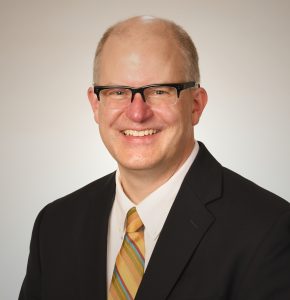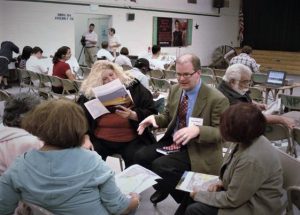
Irish at Heart: An Interview with Peter Vorheees
By Natalie Keller
Last month, I had the privilege of interviewing Peter Vorhees, a Transit, Rail, and Urban Transportation Planning Manager based in Cleveland. His work spans the United States with a focus on D.C., Seattle, and Atlanta, and his specialties include bus corridors, urban streetscapes, commuter and high-speed rail, pedestrian and bicycle access, and green urban drainage and sustainable development.
Vorhees had never read iIrish until striking up a conversation with a neighbor, who recommended my previous article from June 2022, “A Love Letter to Public Transportation.” He then wrote to me to express his interest in my perspective, and an interview was arranged. I am delighted to bring Peter’s work to the attention of the iIrish readership and anyone interested in the future of public transit in Cleveland and our nation.
While planning projects here in America, do you ever take inspiration from Europe’s infrastructure? These are countries that have vast, successful networks of public transportation that could serve as a model for us here in the States.
My work requires thinking like you do when in Europe: how can one get around without a car, and how can that experience be more convenient, enjoyable and civilized than by car?
High speed railroads around the world tend to turn a profit after the infrastructure is made, but getting the infrastructure in place is the challenge, and in a lot of countries, it’s a national investment.
In China, high-speed rail is a national priority. In European countries, it’s been a national investment turned over to private operation. We had a national investment in highways and that’s really what we’ve done in this country since World War II.
There is actually a federal vision [in the US] for high-speed rail. Would people ride it? Absolutely. Are they on the highway now? Are they on planes? Would they be contributing less carbon into the atmosphere if they were on well-utilized, energy-efficient, electrified rail that could be powered by green sources than in short-haul flights, or sitting on the highway?
It’s too bad if all we can think of to connect this region together is highways. That is last generation thinking. It’s not the way we need to act to compete – not just with other cities in the Midwest, to attract economic talent and retain young people – but with our peer regions around North America and cities around the world. To do that, we need to modernize and innovate.
What are the benefits of public transportation versus highways or airplanes?
Our engineers here in the States know how to build interstate transportation in highway form. That culture has been accepted as an ideal. But what I’m encouraged by is that increasingly there are more people who want to work [in public transit].
I’m seeing a lot of trained highway engineers, young people who have been prepared for that industry, get into it and start asking questions: how do I work on bus rapid transit? How do I work on rail transit or high-speed rail? That’s what is capturing their attention.
The only line in this country that comes close to the international definition of high-speed rail is the Northeast Corridor, which is the Amtrak line designed to move between Washington D.C., Philadelphia, New York, and Boston. Enough people travel on trains in the Northeast Corridor that it’s more competitive than flights between a lot of these cities. It’s much more civilized to sit down on the train, open up your laptop, and get to work than to commute on the highway to a meeting and spend the whole day frustrated in traffic. That’s how the business travelers do it – they get on the train.
What are some of the challenges you face in this field?
Cleveland is the center of an active and vital economic engine that extends beyond Cuyahoga County. Within urbanized Northeast Ohio, there are five metropolitan planning organizations all watching out for their own territory, and it can be a challenge for them to work together for the whole of this area. With more coordination, the area could be more competitive for federal funding for regional transportation that extends beyond a county border.

People want connectivity to get to other parts of the [Cleveland] metro-region… we’ve got infrastructure here: the red line, the Rapid, the health-line bus transit. But what are we doing to really maximize that investment? What’s constraining it from growing and modernizing is a shortage of local funding.
Some people will say we don’t invest in transit because Cleveland isn’t growing. But we want to grow as a walkable community, and we want to grow ecologically. People here think of Cleveland as small. In reality, it is the center of a 3.5-million-resident metropolis. The lines between this metropolis and the 2.5 million in greater Pittsburgh are blurred. Functional city life within this mega-region requires urban transportation infrastructure, as our US peer regions are growing. I am confident and hopeful that we can unite as a major urbanity to get there.
What are your hopes for Cleveland’s future?
Young people expect transit. Their hearts don’t get pumping over going to the airport and going through security. They don’t want to see another dozen Walmart’s on their way to the next city. They want to sit on a train and see the shoreline. They want to get off that train and walk into a wonderful historic core with all the commercial activity they’re looking for, a boutique hotel in the midst of it, and maybe a great amusement park that’s a water taxi ride away in Sandusky.
They want that because it’s the way of the future, and what they recognize as meeting all their social and ecological objectives. Cities are often places that are designed for cars and not people, but they must be places that compel your attention constantly… a place you want to be.

We have some corridors in Ohio that would be highly productive, starting with Cleveland, Columbus, Dayton, and Cincinnati. The population concentration along that corridor is comparable to France or parts of Germany, and [people] will definitely ride if the service is there. The culture may not be there yet, but when it exists, it gets used.
The Bipartisan Infrastructure Bill includes 66 billion dollars for intercity passenger rail. With that, I think we can expect to see improvements made in Chicago and south of Lake Michigan to complete that network between Detroit and Chicago. There’s going to be a lot of money for buying more track in other places. What about a place like Cleveland?
*Natalie Keller is a former resident of Galway, Ireland and works in the world of libraries. Her poetry and fiction have appeared in various online platforms, and she is currently editing a novel, much of which is set in the Emerald Isle. She loves to hear from readers at [email protected] at Heart, Natalie Keller, Visa, Working Abroad, Living Abroad, Yeats, Socrates, Medina, Thomas Paine, Kenyon College, Galway, Poetry, Fiction, Writer, #iIrish, #LiveMoreLifeBeMoreIrish, #Shenanigans, iIrish, Ireland, Ohio, iIrish Songs Stories & Shenanigans Podcast, Irish American, https://iirish.us, Craic, Social Media, Facebook, Twitter,

Monthly newsmagazine serving people of Irish descent from Cleveland to Clearwater. We cover the movers, shakers & music makers each and every month.
Since our 2006 inception, iIrish has donated more than $376,000 to local and national charities.
GET UPDATES ON THE SERIOUS & THE SHENANIGANS!